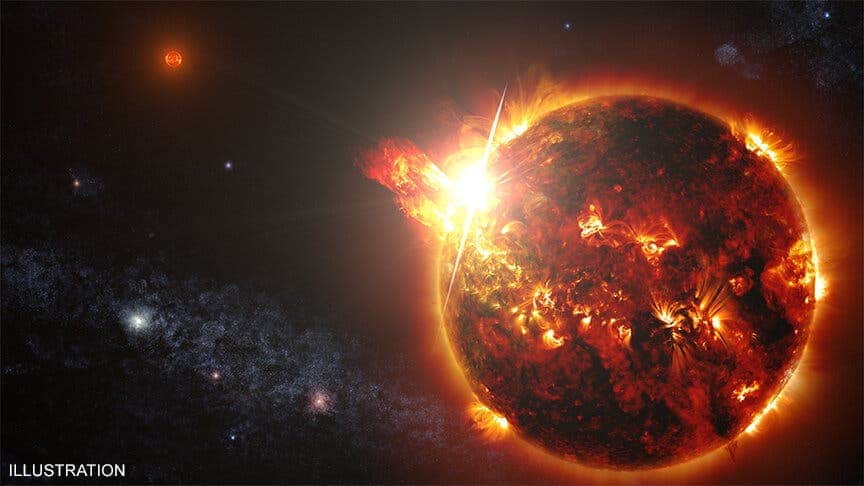An international team of researchers has managed to identify the first coronal mass ejection, or CME, in a star other than our Sun.

An intense flash of X-rays, followed by the bursting on an immense bubble of plasma — that’s what researchers led by Costanza Argiroffi, a researcher at the University of Palermo and associate researcher at the National Institute for Astrophysics in Italy, have seen in the corona of HR 9024, an active star about 450 light-years away from us. This is the first CME ever spotted in a star outside our solar system.
The findings help us better understand how CME fits into the lives of active stars across the Universe and will help us systematically study such dramatic events in the future.
Starburst
“The technique we used is based on monitoring the velocity of plasmas during a stellar flare,” said Costanza Argiroffi. “This is because, in analogy with the solar environment, it is expected that, during a flare, the plasma confined in the coronal loop where the flare takes place moves first upward, and then downwards reaching the lower layers of the stellar atmosphere.”
“Moreover, there is also expected to be an additional motion, always directed upwards, due to the CME associated with the flare.”
The team used data collected by NASA’s Chandra X-ray Observatory to analyze a “particularly-favorable” flare, according to a Chandra Observatory press release. Solar flares are sudden, quite violent events, during which a star’s brightness increases substantially. Flares are sometimes, but not always, associated with CMEs.
The High-Energy Transmission Grating Spectrometer (HETGS) device aboard Chandra is the only instrument we have at our disposal so far that can be used to measure the movement of matter involved in CMEs. CMEs involve the expulsion of plasma — very hot, electrically-charged gas — in a star’s corona (atmosphere), at speeds of up to tens of thousands of miles per hour.
CMEs are only produced in magnetically-active stars, the results confirm. The findings also support the validity of what we know about CMEs so far, for example, that material involved in a flare is very, very hot (from 18 to 45 million degrees Fahrenheit), and that it first rises and then drops with speeds between 225,000 to 900,000 miles per hour.
“This result, never achieved before, confirms that our understanding of the main phenomena that occur in flares is solid,” said Argiroffi. “We were not so confident that our predictions could match in such a way with observations, because our understanding of flares is based almost completely on observations of the solar environment, where the most extreme flares are even a hundred thousand times less intense in the X-radiation emitted.”
The “most important” discovery, however, is that after the flare a body of much cooler plasma (of around 7 million degrees Fahrenheit) rises from the star’s body with “a constant speed of about 185,000 miles per hour,” adds Argiroffi. Such a result is “exactly what one would have expected for the CME associated with the flare.”
The team adds that, based on Chandra’s readings, the mass of the CME in questions was roughly two billion pounds. This would make it about ten thousand times as massive as the largest CMEs put out by the Sun. This last tidbit reinforces the idea that more magnetically active stars generate larger-scale versions of solar CMEs.
“The observed speed of the CME, however, is significantly lower than expected. This suggests that the magnetic field in the active stars is probably less efficient in accelerating CMEs than the solar magnetic field,” Argiroffi concludes.
The paper “A stellar flare−coronal mass ejection event revealed by X-ray plasma motions” has been published in the journal Nature.


